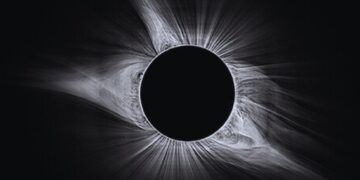Ever wished you could witness a total solar eclipse every day? Well, fret no more! NASA has unveiled a fantastic new online tool called Eclipse Watch that brings the thrill of eclipses to your fingertips. Buckle up and prepare to be dazzled by the Sun’s magnificent corona – all from the comfort of your web browser.
A Virtual Eclipse Experience: Unveiling the Sun’s Corona
Eclipse Watch leverages data from the Solar and Heliospheric Observatory (SOHO), a joint NASA-ESA mission stationed a million miles from Earth. This powerful spacecraft captures real-time images of the Sun, offering a glimpse of its outer atmosphere, the corona. Using Eclipse Watch is as simple as refreshing the page – with each refresh, you’ll be presented with a brand new solar image. These captivating images showcase the very features you would witness during a total solar eclipse on Earth, where the Moon conceals the Sun’s blinding brilliance.
Why Eclipses Matter: Unveiling the Sun’s Secrets
A total solar eclipse offers a rare opportunity to study the Sun’s extended atmosphere, typically hidden by the Sun’s intense light. During these celestial spectacles, we can observe the scorching hot gas streaming outwards from the Sun’s surface into space. Scientists traditionally rely on specialized telescopes called coronagraphs to mimic eclipses and study the corona. These instruments essentially create artificial eclipses by blocking the Sun’s light with a disc, mimicking the Moon’s role during a real eclipse.
Eclipse Watch: A Sneak Peek at the April 8th Solar Eclipse
The Helioviewer Eclipse Watch goes a step further, providing you with a “virtual eclipse” experience. This tool utilizes images captured by the Large Angle and Spectrometric Coronagraph Experiment (LASCO) instrument onboard SOHO. LASCO captures the Sun’s corona over a hundred times each day, and Eclipse Watch presents these images for your viewing pleasure. These images also allow you to peek ahead at the upcoming total solar eclipse on April 8th, 2024. While LASCO’s view is partially obscured by its own disc (larger than the Moon will block during the eclipse), it provides a tantalizing glimpse of the breathtaking spectacle that awaits. A handy image overlay even shows the Moon to scale, highlighting the additional corona you’ll witness during the actual eclipse.
SOHO: Unveiling the Sun’s Mysteries
SOHO, launched in 1995, has become an invaluable tool for studying our Sun. From its fiery core to its wispy outer corona, SOHO’s suite of 12 instruments has been unraveling the Sun’s secrets for nearly three decades. One of these instruments, LASCO, plays a starring role in Eclipse Watch. Beyond capturing coronal images, LASCO has also been instrumental in identifying coronal mass ejections – massive bursts of solar material that can impact Earth’s magnetosphere. SOHO has even played a role in cometary science, with thousands of sungrazing comets spotted in its images.
Mark Your Calendars: The April 8th Total Solar Eclipse
The much-anticipated total solar eclipse on April 8th, 2024, will be visible across parts of Mexico, the United States, and Canada. A convenient countdown timer on the Eclipse Watch page keeps you updated on the approaching celestial event. If you’re lucky enough to be within the path of totality, your eclipse experience may even surpass the views offered by LASCO. Just remember, safe solar viewing practices are essential! Specialized eye protection is a must, with the exception of the brief period of totality when the Moon entirely covers the Sun.
Eclipse Watch: Beyond the Casual Observer
Eclipse Watch isn’t just for eclipse enthusiasts. This tool is an extension of Helioviewer, a free and open-source visualization tool developed by NASA. Helioviewer empowers researchers to delve deeper into solar phenomena, acting as a virtual “map app” for the Sun. Users can select specific data sets captured by various spacecraft instruments and even create their own movies of solar events. This interactive platform fosters exploration and discovery, allowing researchers to pinpoint, track, and analyze solar activity. For those who crave an even more in-depth experience, a downloadable version called JHelioviewer with 3D movie creation capabilities is also available.

So, what are you waiting for? Head over to Eclipse Watch and embark on a virtual solar adventure! This innovative tool brings the wonders of the Sun’s corona to your screen, and with the much-anticipated eclipse on the horizon, it’s the perfect time to explore the magic of these celestial spectacles.



















